Homemade spaghetti noodles made with fresh pasta have about 1000% more flavor than the dry packaged noodles plus they are the healthier choice. And guess what? Making spaghetti noodles from scratch is a breeze, so why settle for less?
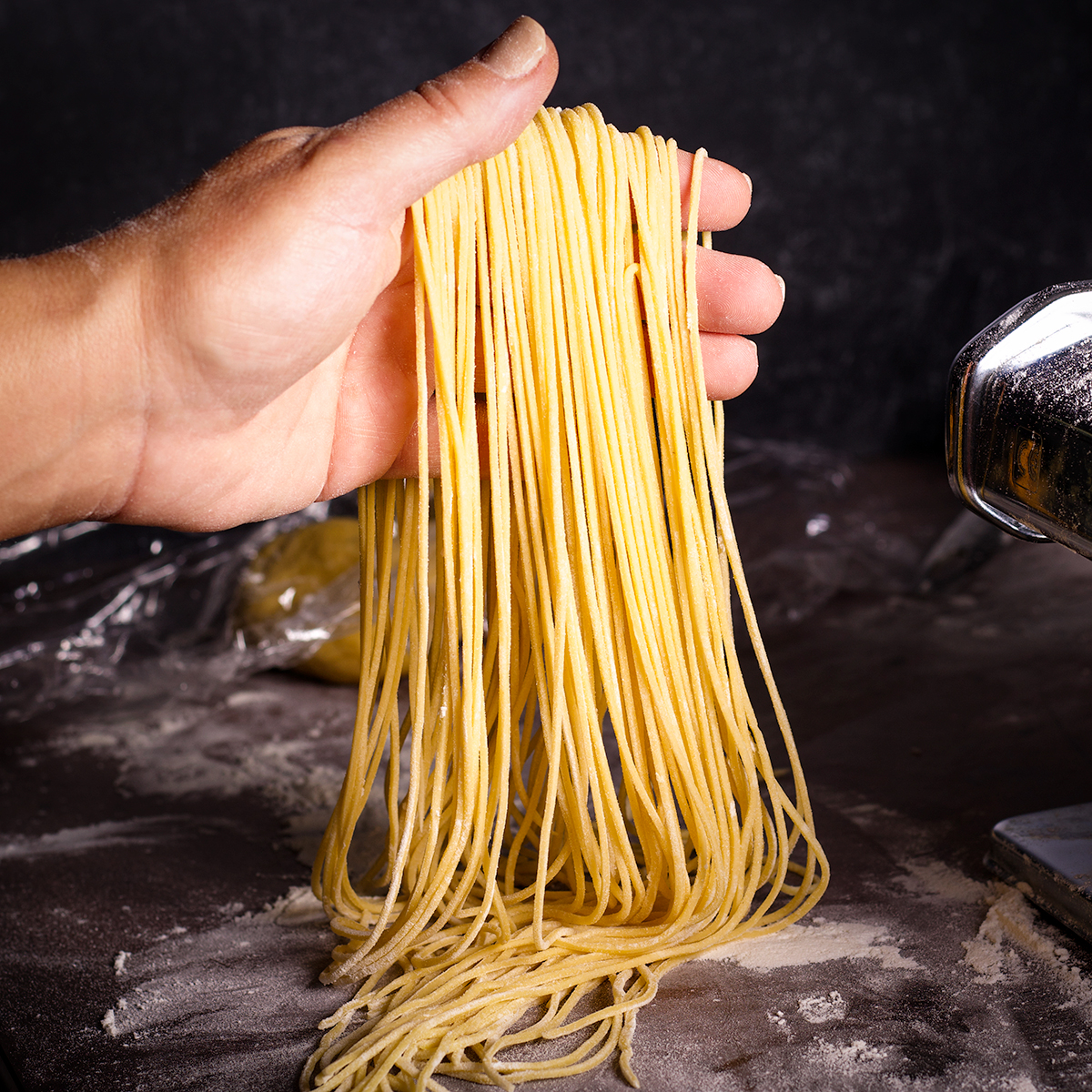
This recipe for homemade spaghetti produces noodles with a rich, buttery egg yolk flavor that is so good you may never purchase dried pasta again!
Jump to:

+ Subscribe to my newsletter for new and exclusive recipes in your in-box every month! As a full time traveler, living, working, cooking, and baking from a 5th wheel RV, it's also where I share our experiences of life on the road.
Ingredients needed to make spaghetti from scratch
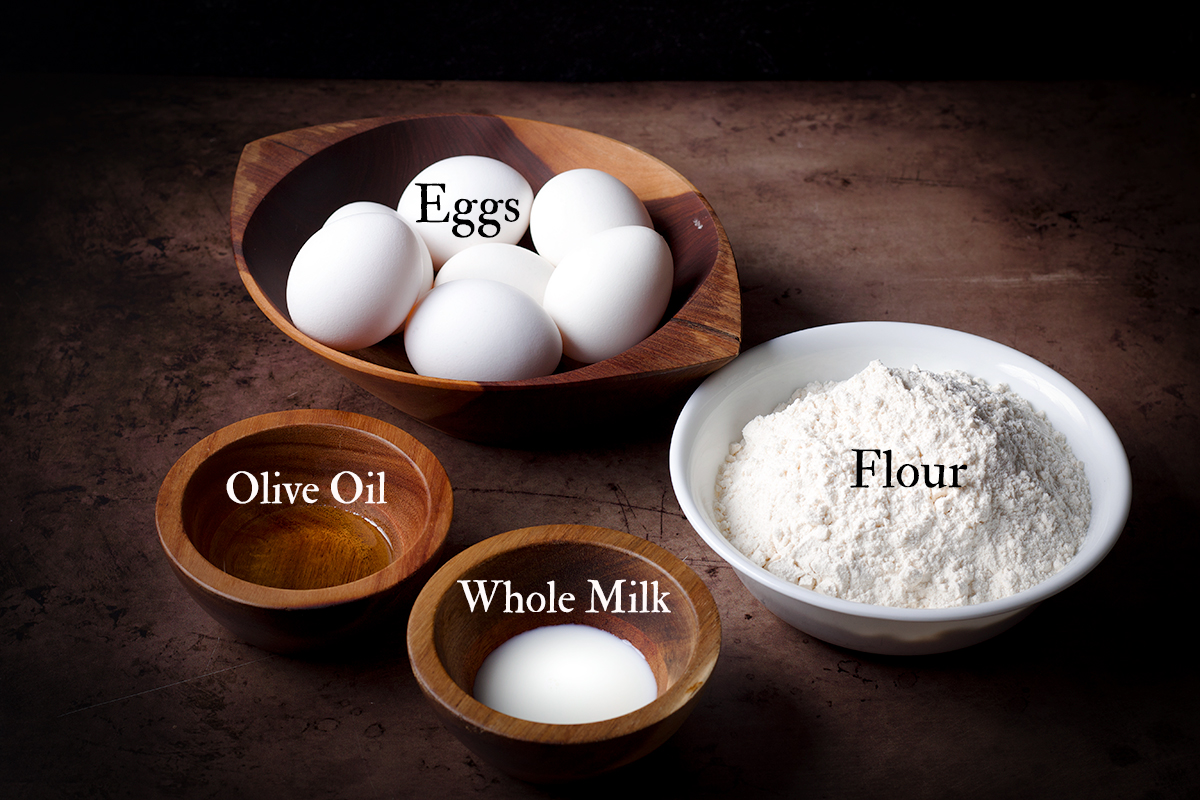
You just need 4 ingredients to make spaghetti noodles from scratch:
- Eggs. The ratio of using one whole egg plus six egg yolks makes the absolute BEST spaghetti noodles that are rich, flavorful, and packed with protein and other nutrients.
- Flour. You can use all-purpose flour or "oo" flour. They are interchangeable in this recipe but will create a slightly different texture. See below for a comparison of all the different kinds of flour used to make pasta.
- Whole milk. One tablespoon of milk adds the perfect amount of moisture for this homemade pasta dough recipe.
- Olive oil. Just two teaspoons of olive oil adds flavor to spaghetti noodles and makes the dough more supple and easy to roll out.
About egg yolk pasta
Years ago, when I first learned how to make pasta, I made it with whole eggs rather than mostly egg yolks. It was so much more delicious than the dried packaged pasta I'd been using that I didn't question it.
One day I came across the recipe for Thomas Keller's pasta in The French Laundry Cookbook and was startled to learn that he only uses one whole egg and then 250 grams of egg yolks per 500 grams of flour. I tried it immediately and haven't looked back. Here's what I love about egg yolk pasta:
- It's more flavorful. Egg yolks have more flavor than egg whites. So, of course, if you use more egg yolks in pasta than egg whites, you'll end up with a more flavorful pasta.
- Egg yolk pasta has a more appetizing appearance. I love sprinkling ground sumac into scrambled eggs but it gives them the most unfortunate grey appearance that you honestly have to do your best to ignore in order to really enjoy them. Color affects our experience of food and noodles that are rich in color simply looks more appealing and delicious. When you use mostly egg yolks in your pasta, especially if you use farm fresh free range eggs with bright yellow-orange yolks, the pasta takes on the gorgeous color of the yolks and makes it look as delicious as it tastes.
- It's more nutritious. I am not trying to make any dietary recommendations or nutritional claims so save your angry comments pretty please. What I AM saying is that egg yolks contain more protein and other nutrients than egg whites including calcium, iron, zinc, copper, manganese, vitamin B6, folate and vitamin B12.
But, if you're skeptical, there's no reason to not test it for yourself. This pasta recipe calls for one whole large egg plus six large egg yolks. That amounts to about 140 grams in total. Measure this amount in whole eggs (about 3 whole eggs) and make a batch of homemade spaghetti noodles as directed. Then make a batch with one whole egg and six egg yolks. Compare the two versions and see which one you prefer.
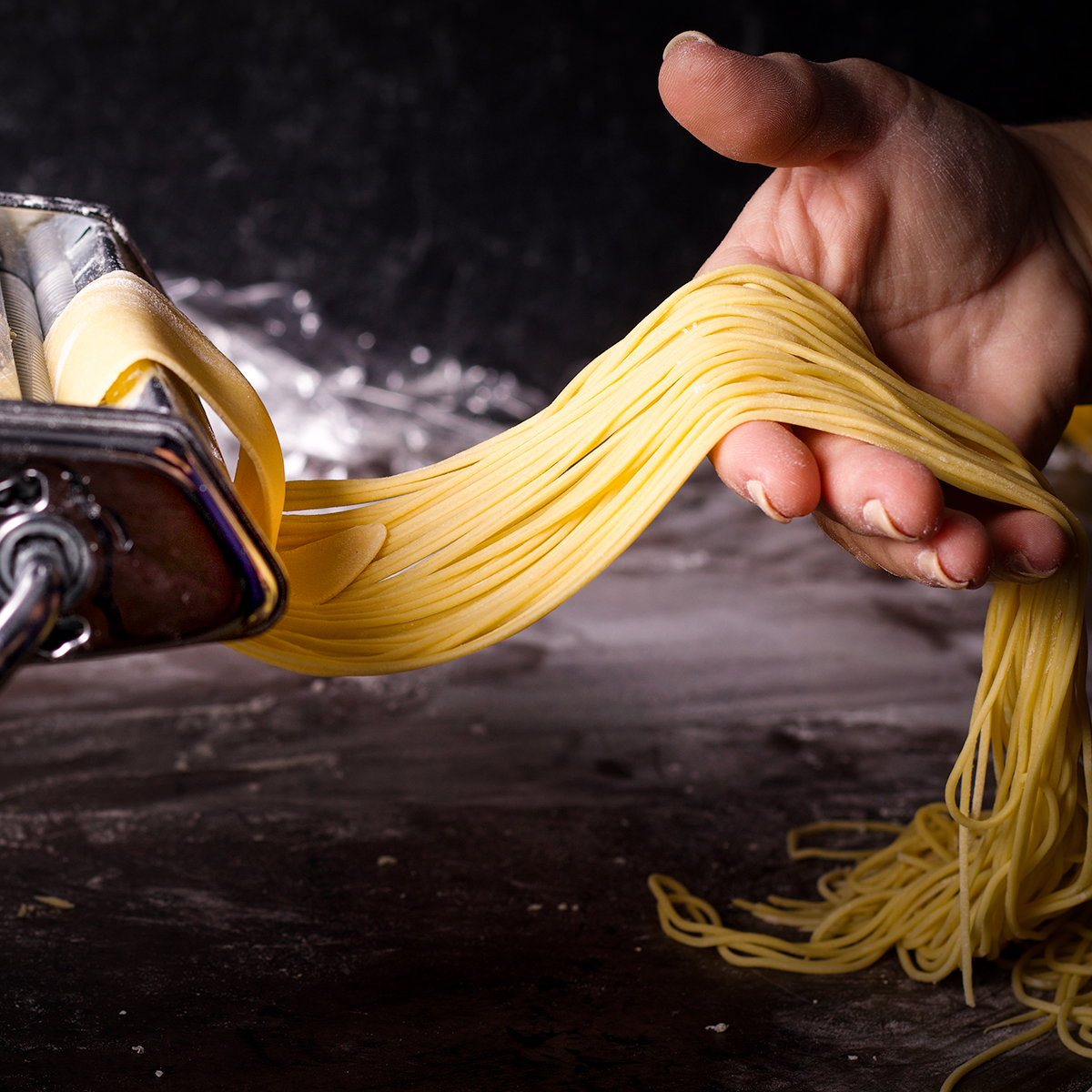
The best flour for pasta dough
“00” flour is often called Italian-style flour. It's milled from the hardest variety of wheat and has a very high protein content. Even though it's made from hard wheat, 00 flour has a super-fine texture. When used to make pasta, that fine texture makes it easy to roll pasta dough into very thin sheets. For this reason, it's considered the best choice for fresh pasta making.
But all-purpose flour works nearly as well. Unless you are making extremely delicate noodles like angle hair pasta, you won't notice much, if any, difference. All-purpose flour is almost always what I use to make spaghetti noodles because I always have it in my pantry.
Semolina flour is a coarse ground flour often used to make couscous, pizza dough, pasta, as well as many desserts. It absorbs much more liquid than other kinds of flour, so if you use semolina to make pasta dough you will most likely need to add more milk to keep the dough from being dry and crumbly.
Often when you see a recipe for pasta dough that calls for semolina flour it will also include some all-purpose flour in order to lessen some of its coarseness. I especially like to use semolina flour to make lasagna noodles, especially when making a lasagna that's packed with many layers of ingredients like this skillet vegetable lasagna.
Every now and then, you'll come across a recipe for fresh pasta that calls for bread flour. Because of its very high protein count, bread flour is the strongest kind of flour. Using bread flour to make pasta will create a texture that's slightly coarse and very elastic. This can be useful if you want a thicker noodle that will stand up to a meaty sauce like bolognese sauce.
How to make spaghetti noodles from scratch
Making fresh pasta requires little hands-on time but a lot of resting time. It's important to allow the dough to rest for several hours before cutting it into noodles. It's also important to let the spaghetti noodles dry out for a few hours before cooking them. So, plan accordingly.
Fresh pasta dough will keep well in the refrigerator for up to a week. So, I often make a batch on the weekend with the intention of pulling it out later that week to use it for dinner.
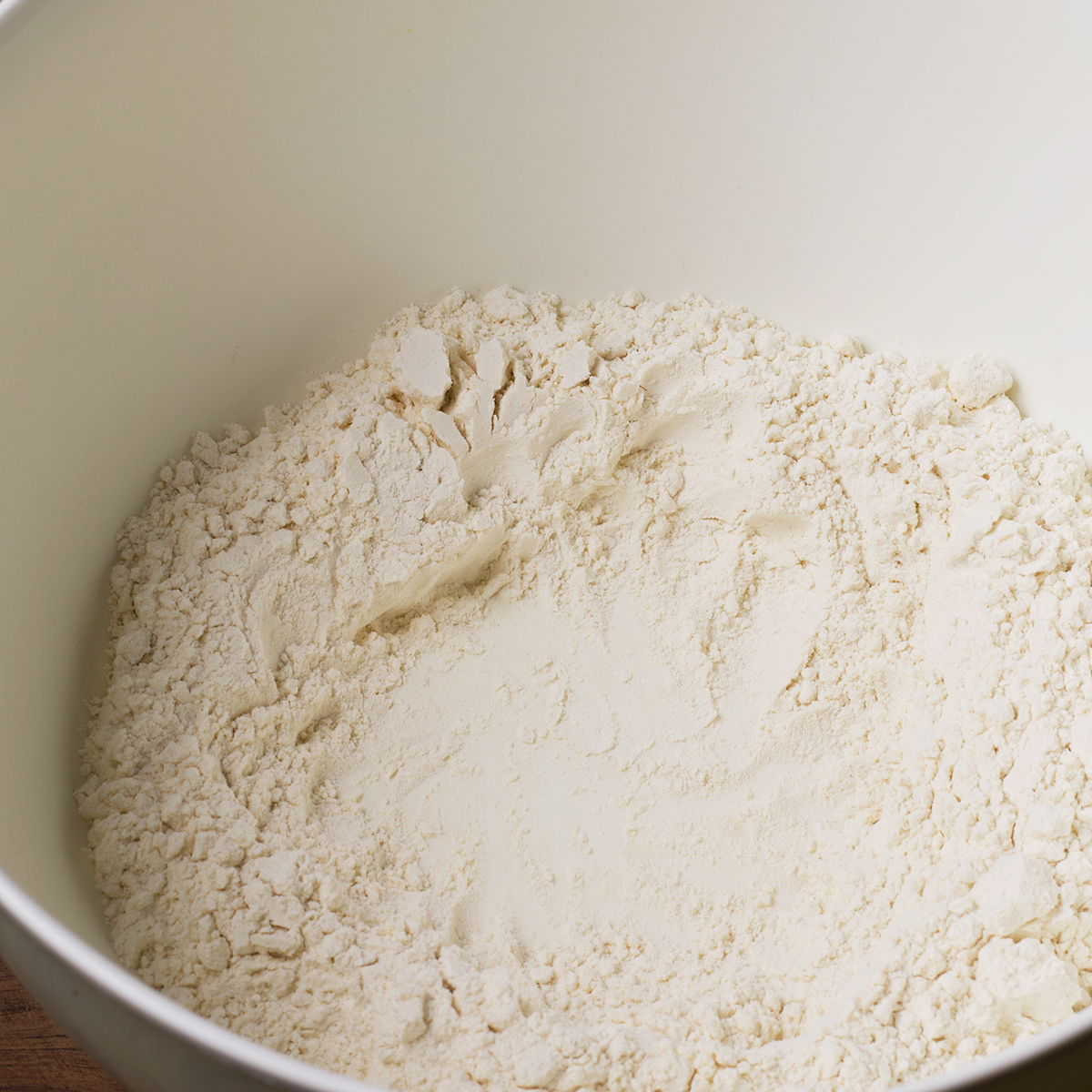
Add the flour to a large bowl or just pile it onto your work surface. Use your hands to create a well in the center of the flour that's large enough to contain the eggs.
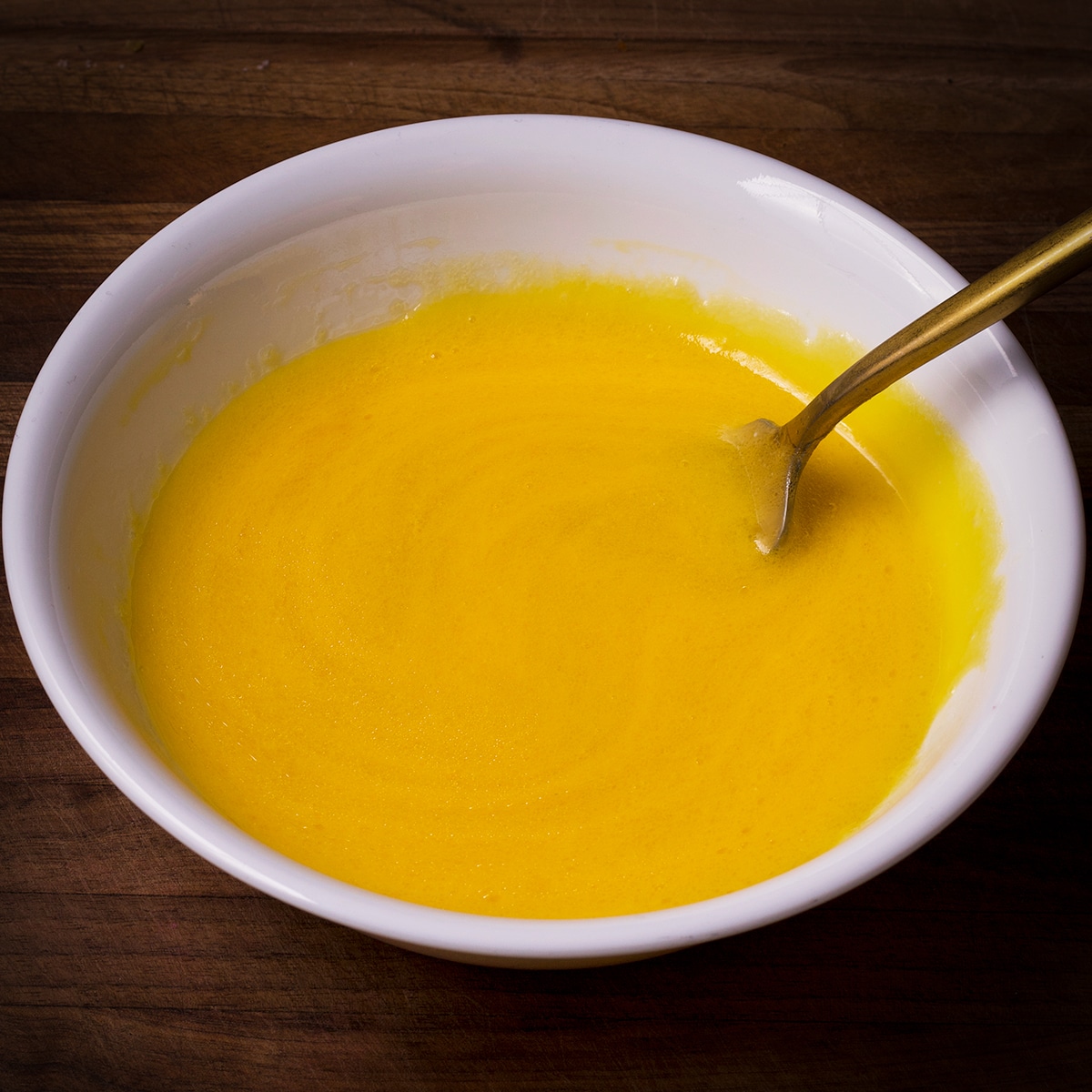
Crack the egg and egg yolks into a bowl and whisk briefly to break them up and combine them.
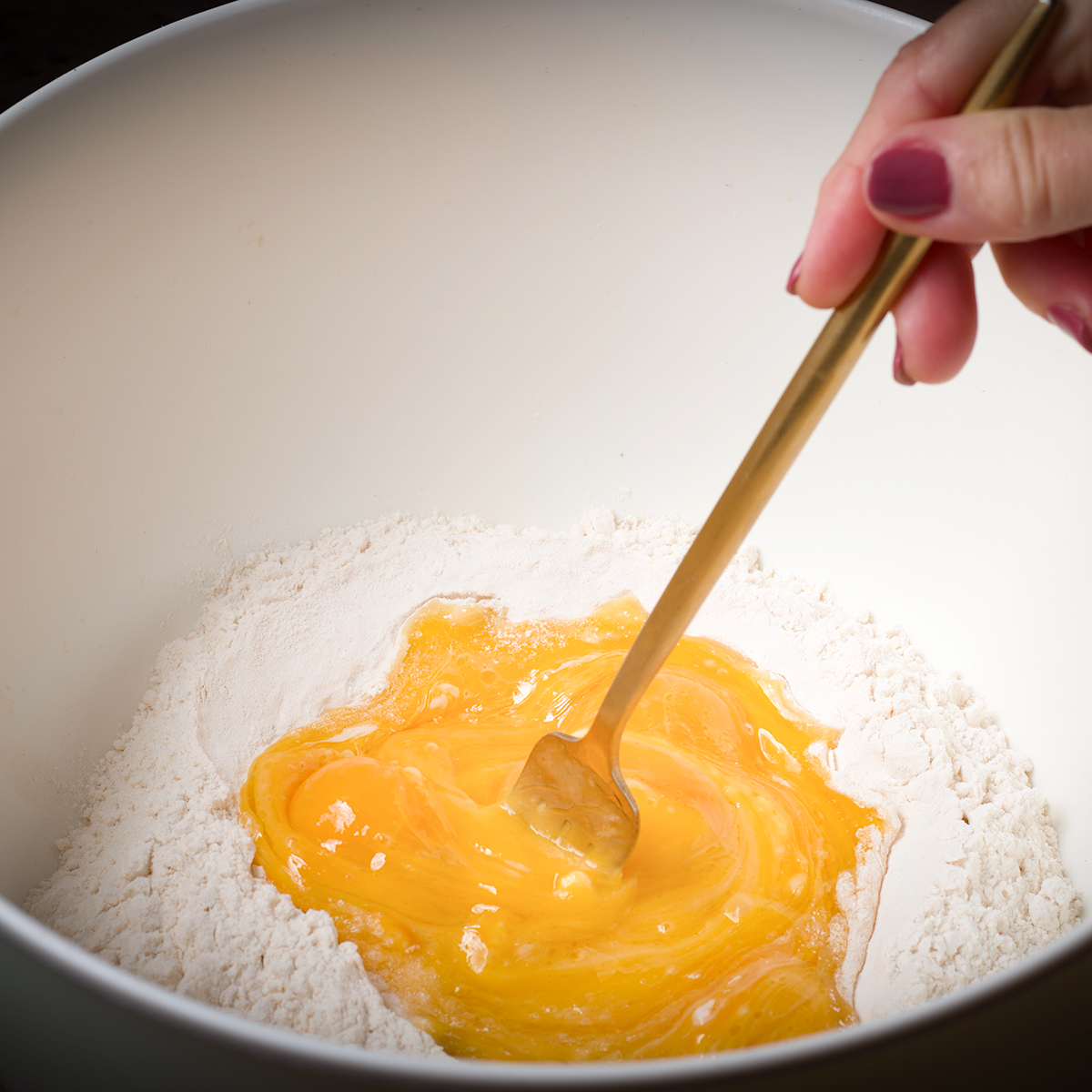
Pour the eggs into the well you created in the center of the flour and add the milk and olive oil.
Using a fork, begin to whisk the eggs into the flour.
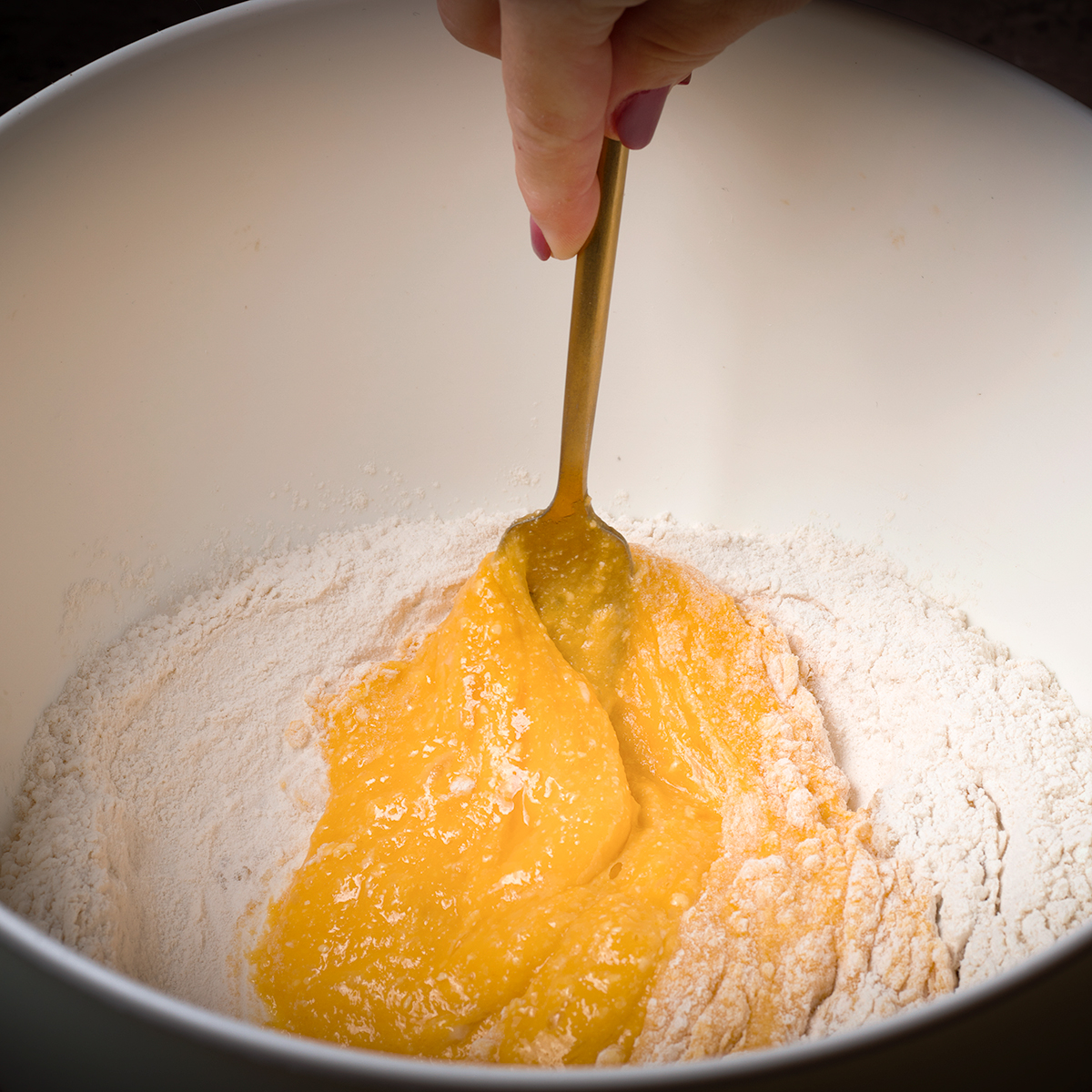
Do this slowly, incorporating more and more flour as you whisk.
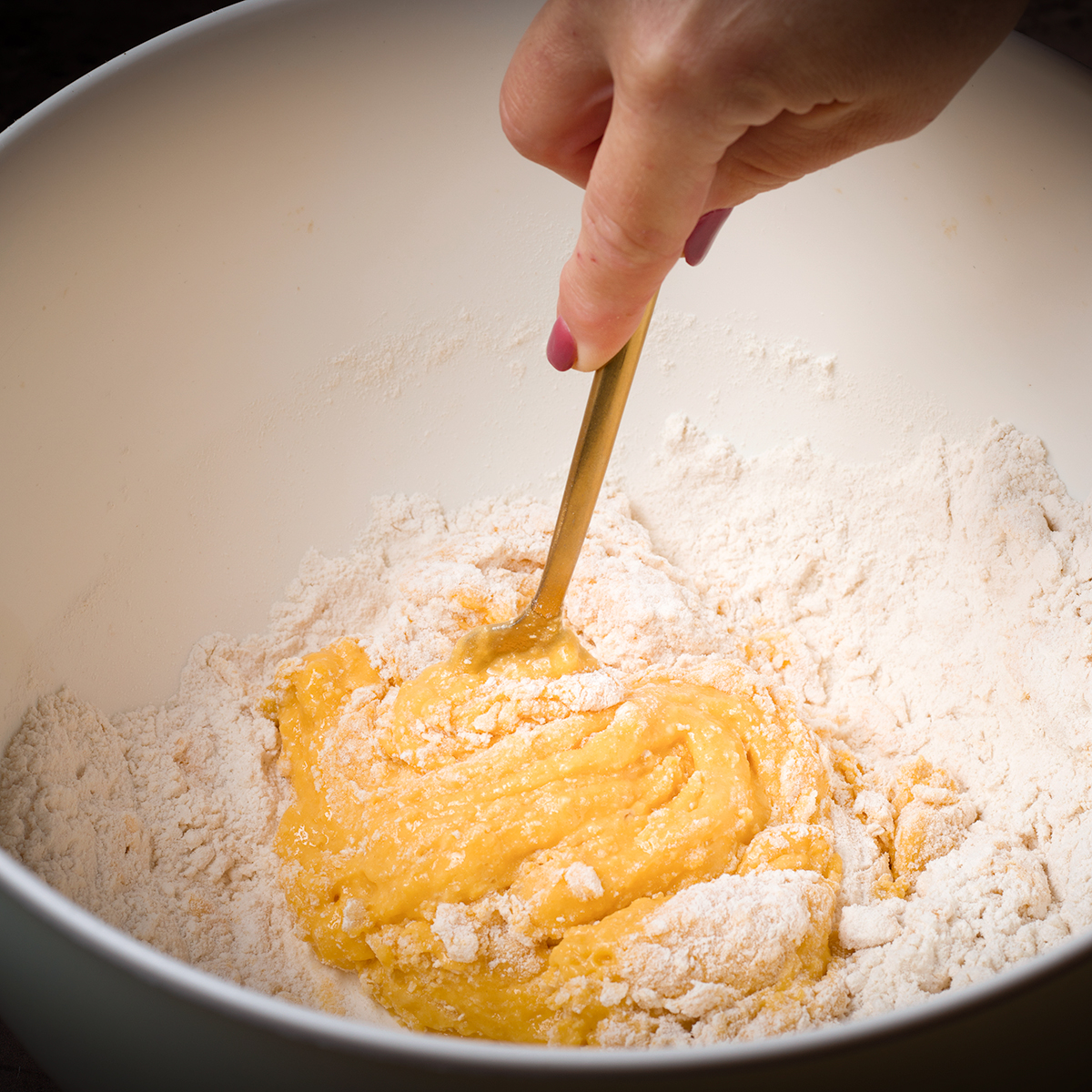
As you continue to incorporate more flour into the eggs, the mixture will begin to turn into a dough.
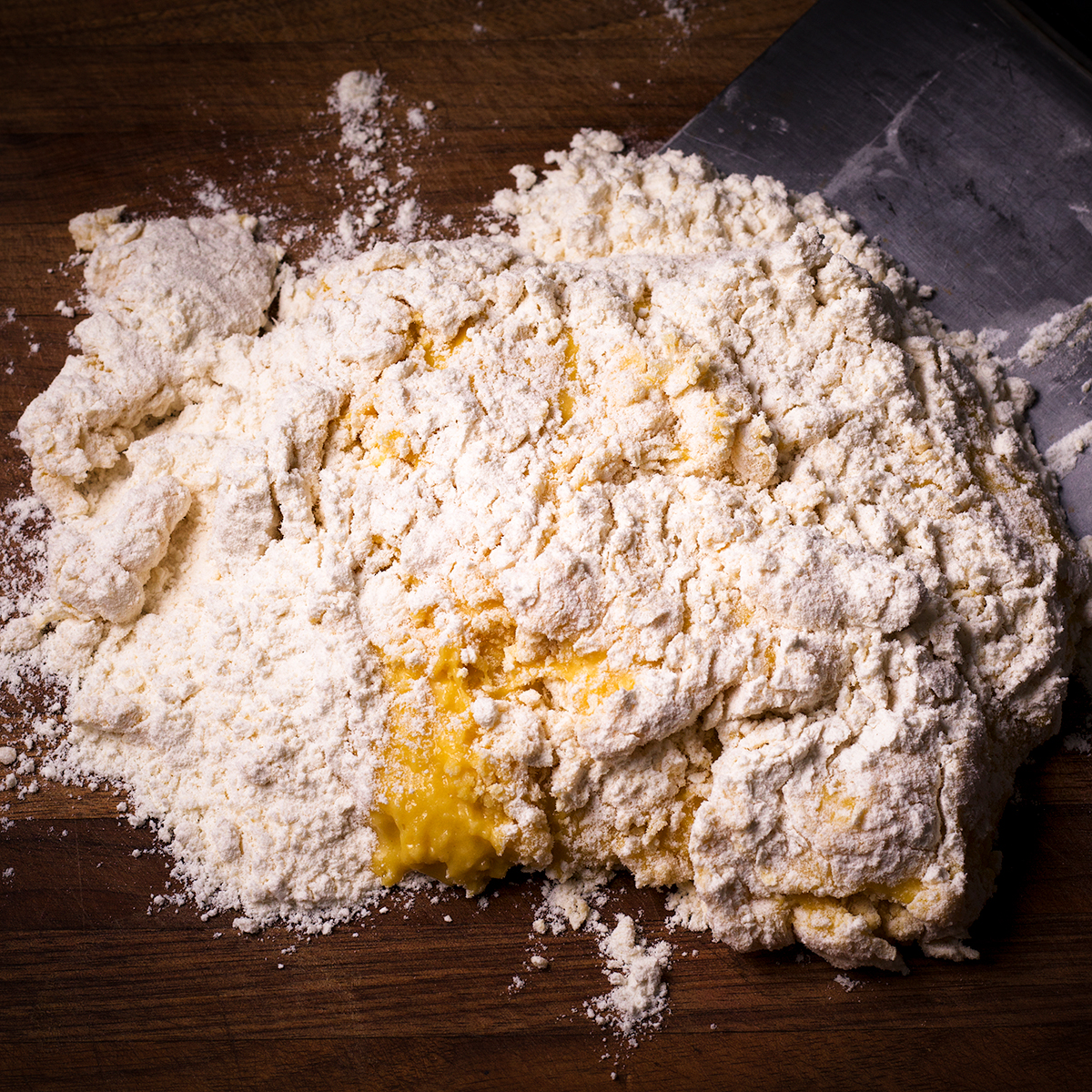
When the mixture becomes thick enough that it's difficult to whisk, dump the whole mess out onto a work surface.
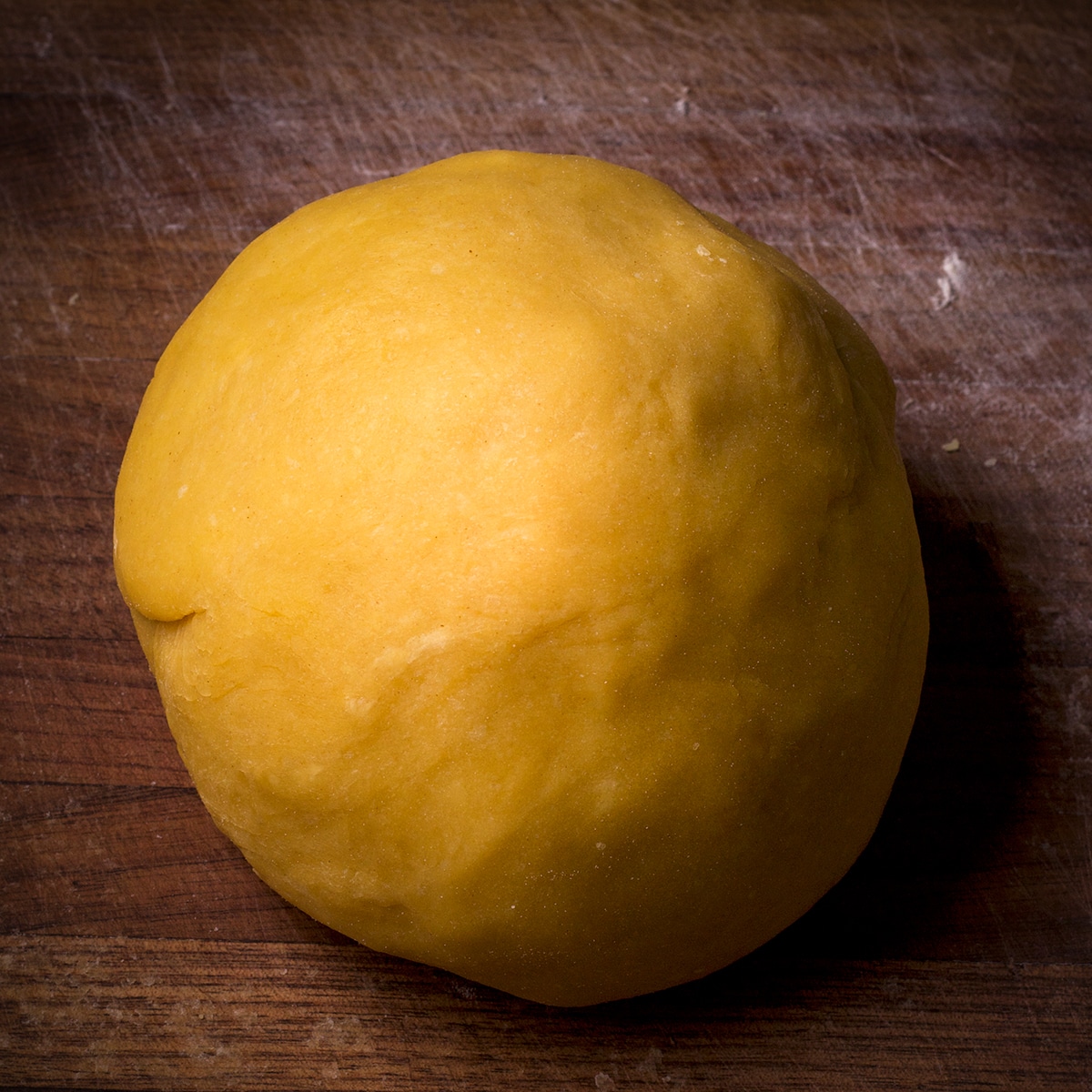
Use your hands to knead the dough, incorporating as much flour as possible, until the dough is smooth and not sticky.
It's important to knead the dough long enough, at least 10 minutes. The dough will be stiff and dry - not so dry that it's crumbling, but dry enough to not stick to anything.
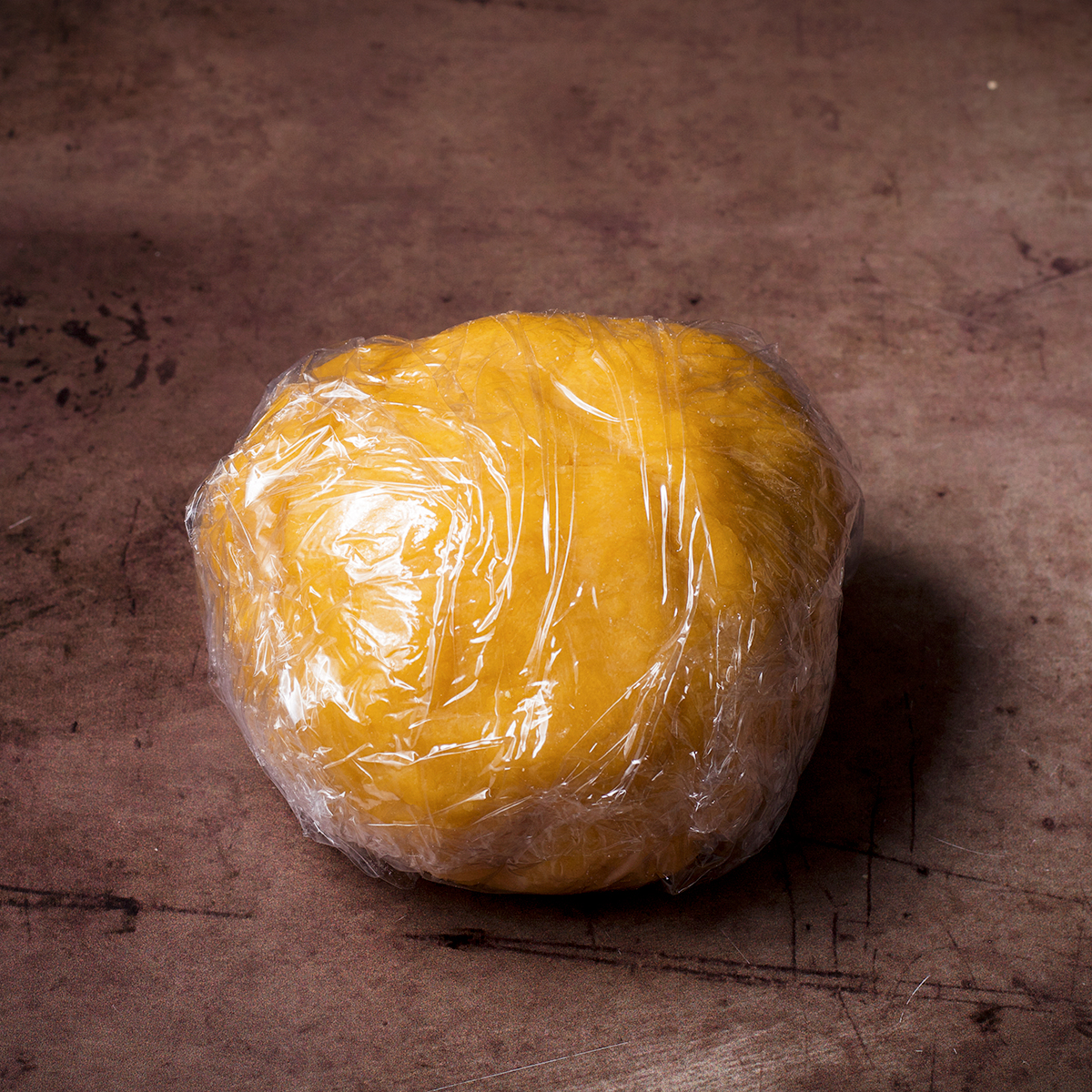
Wrap the dough tightly and place it in the refrigerator to rest for at least 5 hours and up to a week.
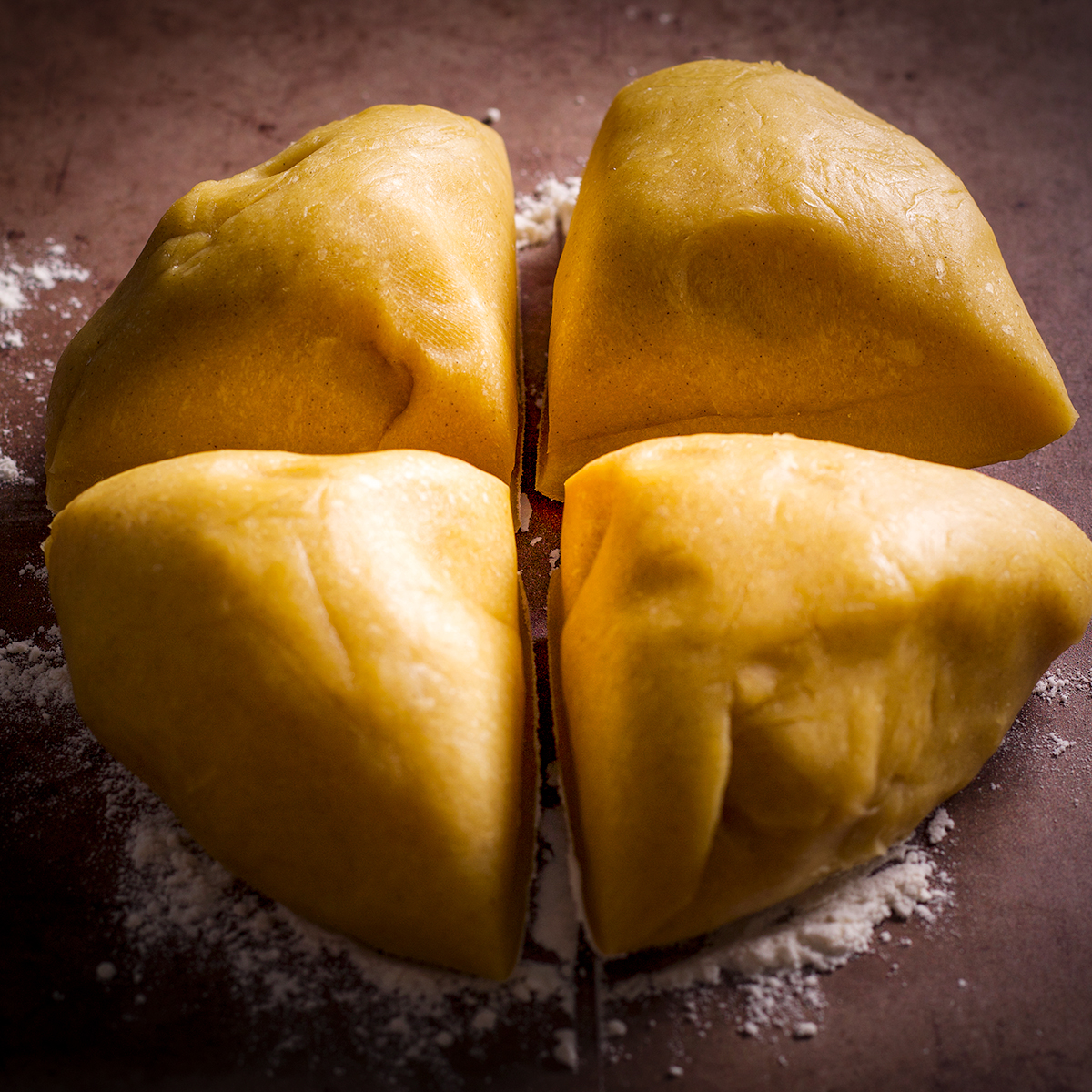
When you're ready to roll out the dough and cut it into strands of spaghetti noodles, remove it from the refrigerator, unwrap it, and set it on a surface that's been dusted with flour.
Cut it into 4 equal pieces. Work with one piece at a time, keeping the remaining dough covered.
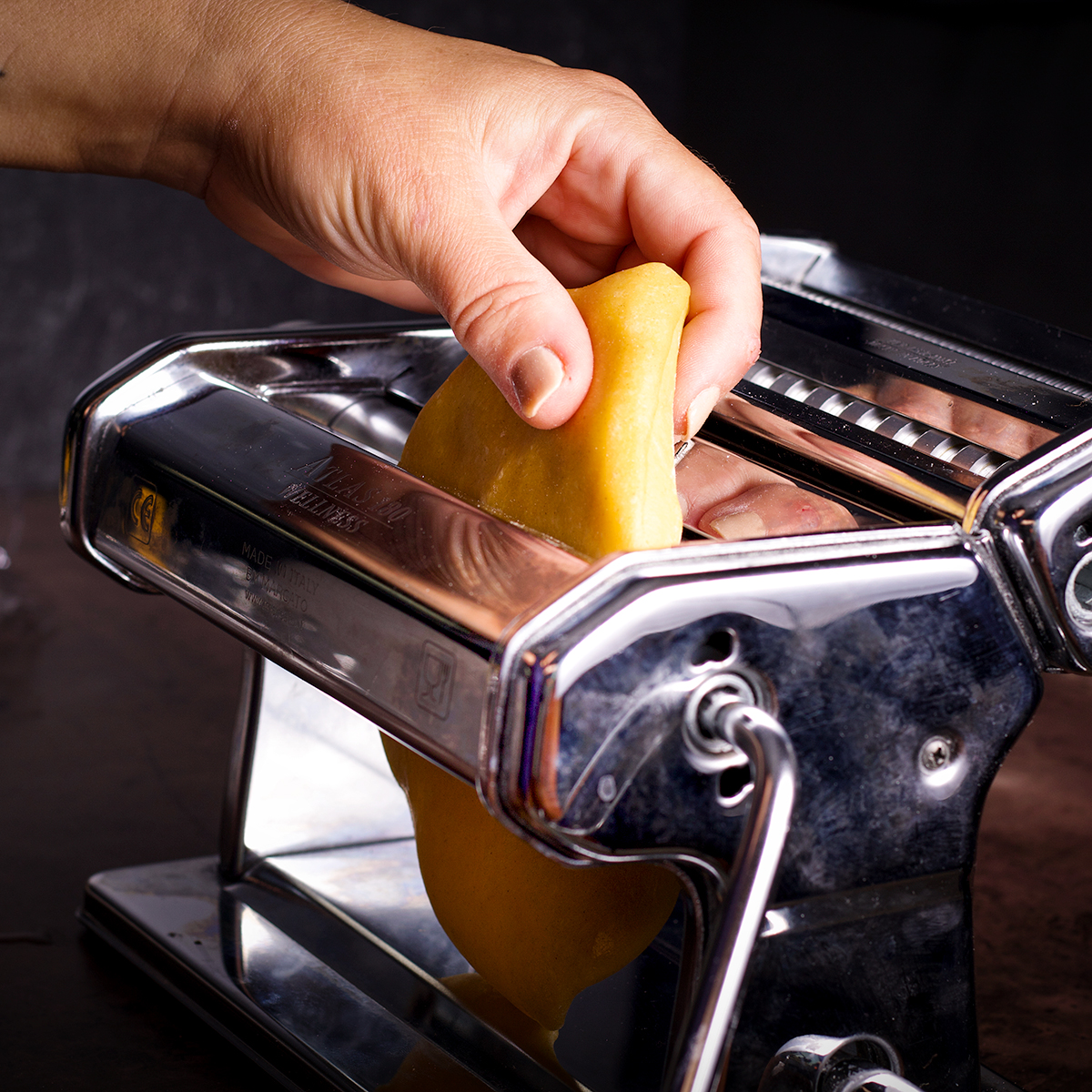
Begin feeding one piece of dough through the rollers of a pasta machine set to it's widest setting. On my Marcato Pasta Maker, this means setting the rollers to "0".
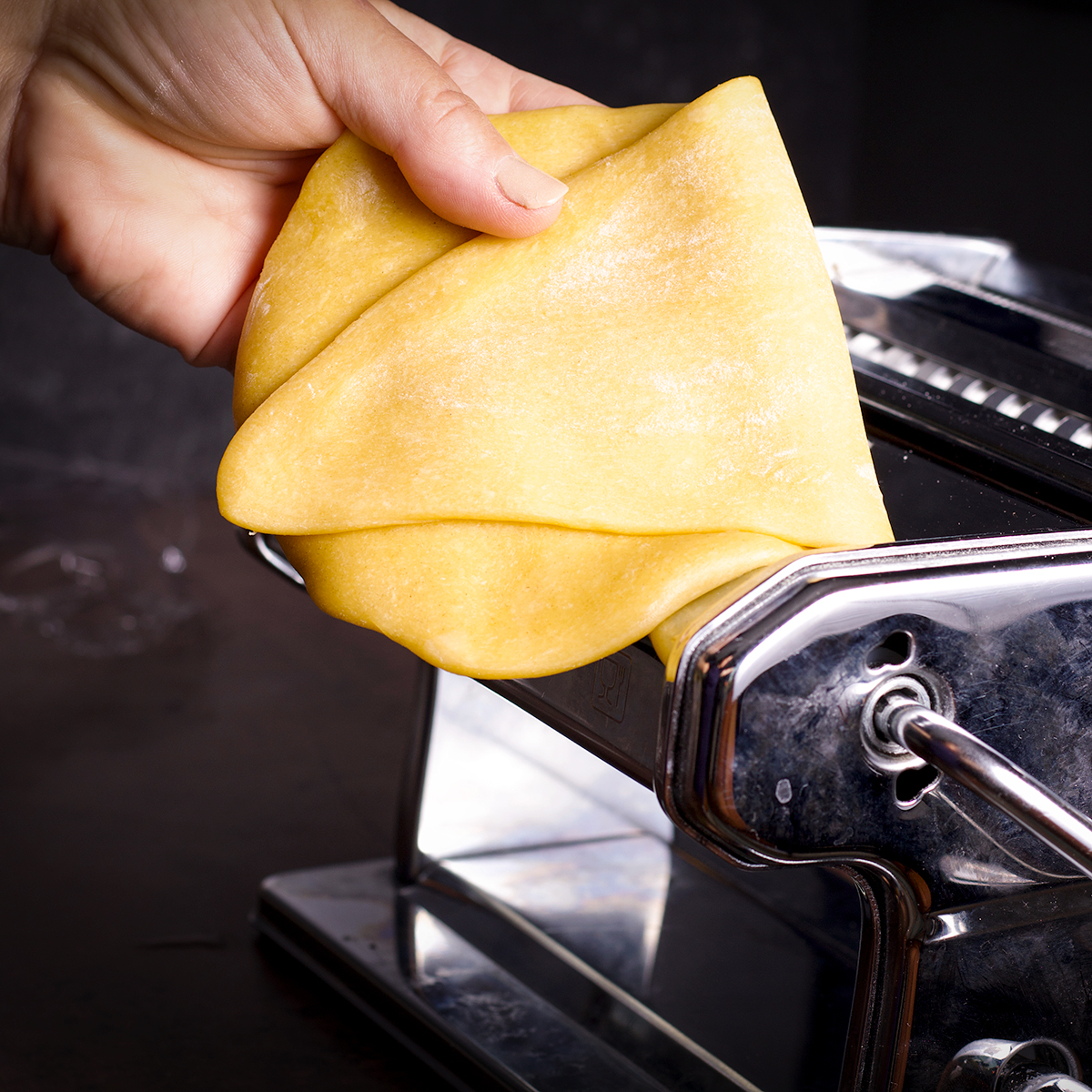
After rolling it through the machine, fold it in half and roll it through again.
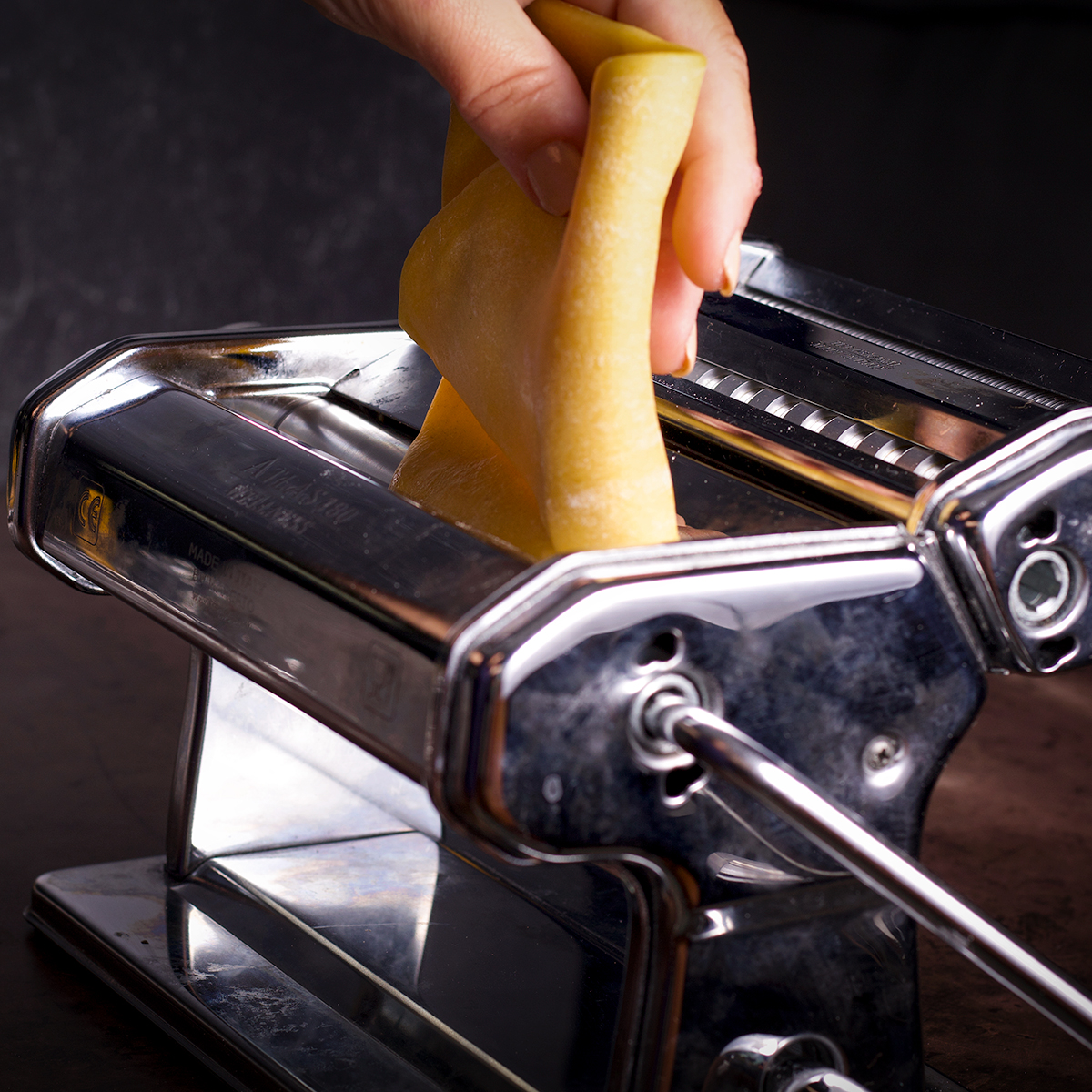
Continue to fold the pasta in half and feed it back through the machine's rollers at least another 8 - 10 times with the machine at it's widest setting. Every once in a while, dust the dough with flour to keep it from becoming sticky.
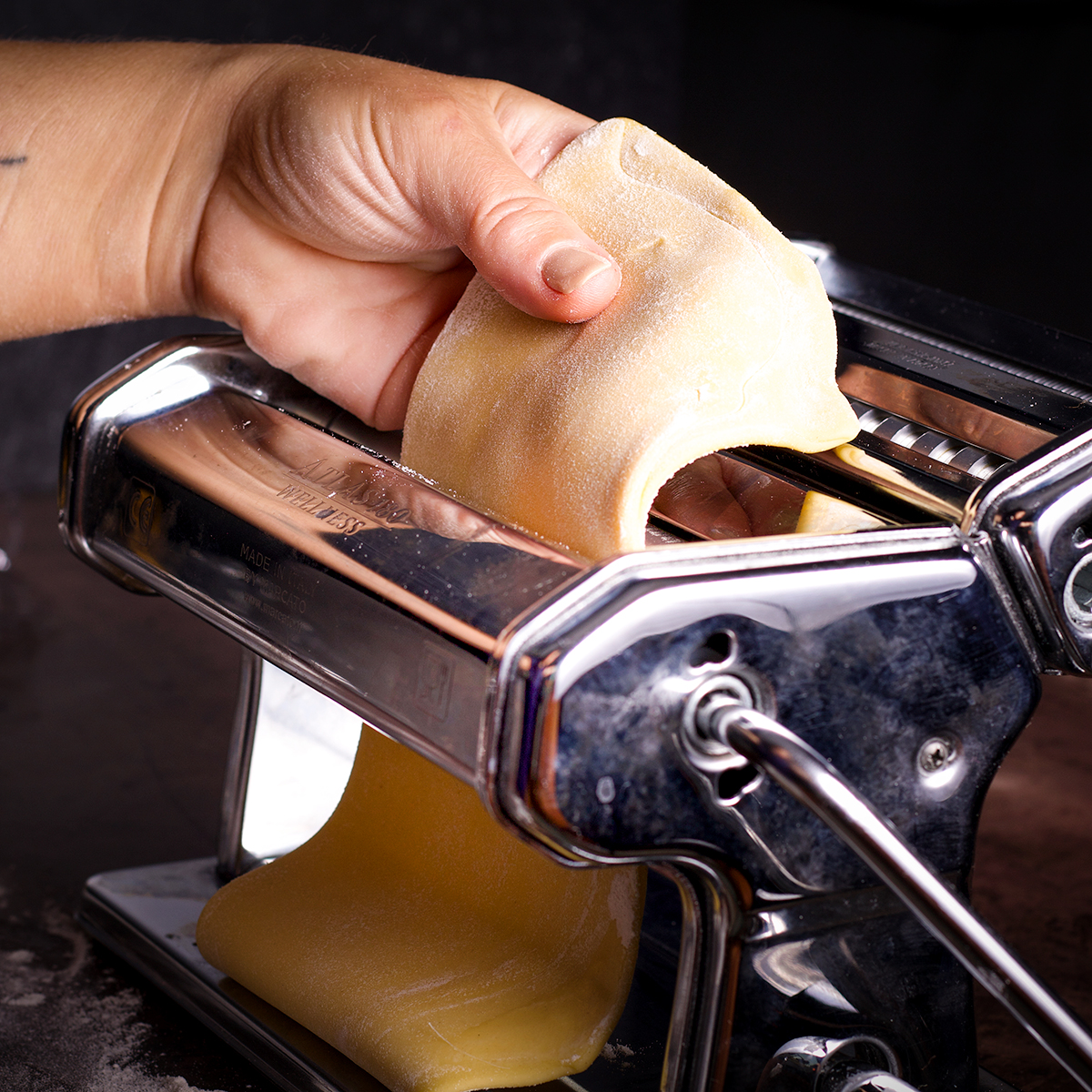
Continue to feed the dough through the machine's rollers, slowly narrowing the width of the rollers from "0" to "4" or "5". You can go thinner if you like - it really just depends on how thick you want the strands of spaghetti. I usually stop at "4" because I prefer fat, chewy spaghetti noodles.
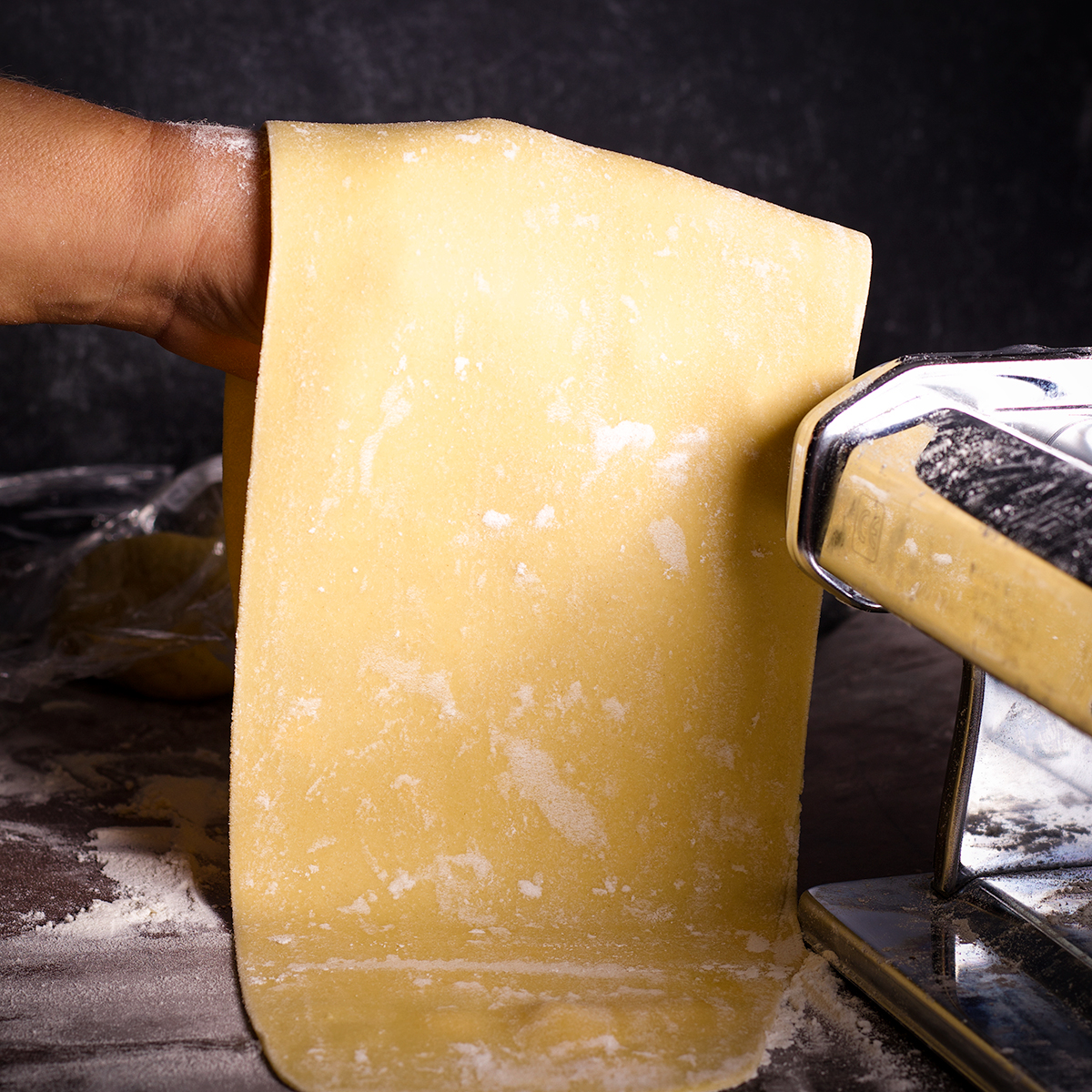
As you continue to roll the dough through the machine, it will get thinner and longer. Stop to dust it with flour frequently. It's important to incorporate enough additional flour to keep the dough dry enough to prevent the strands from sticking together when you cut the sheet of pasta into spaghetti.
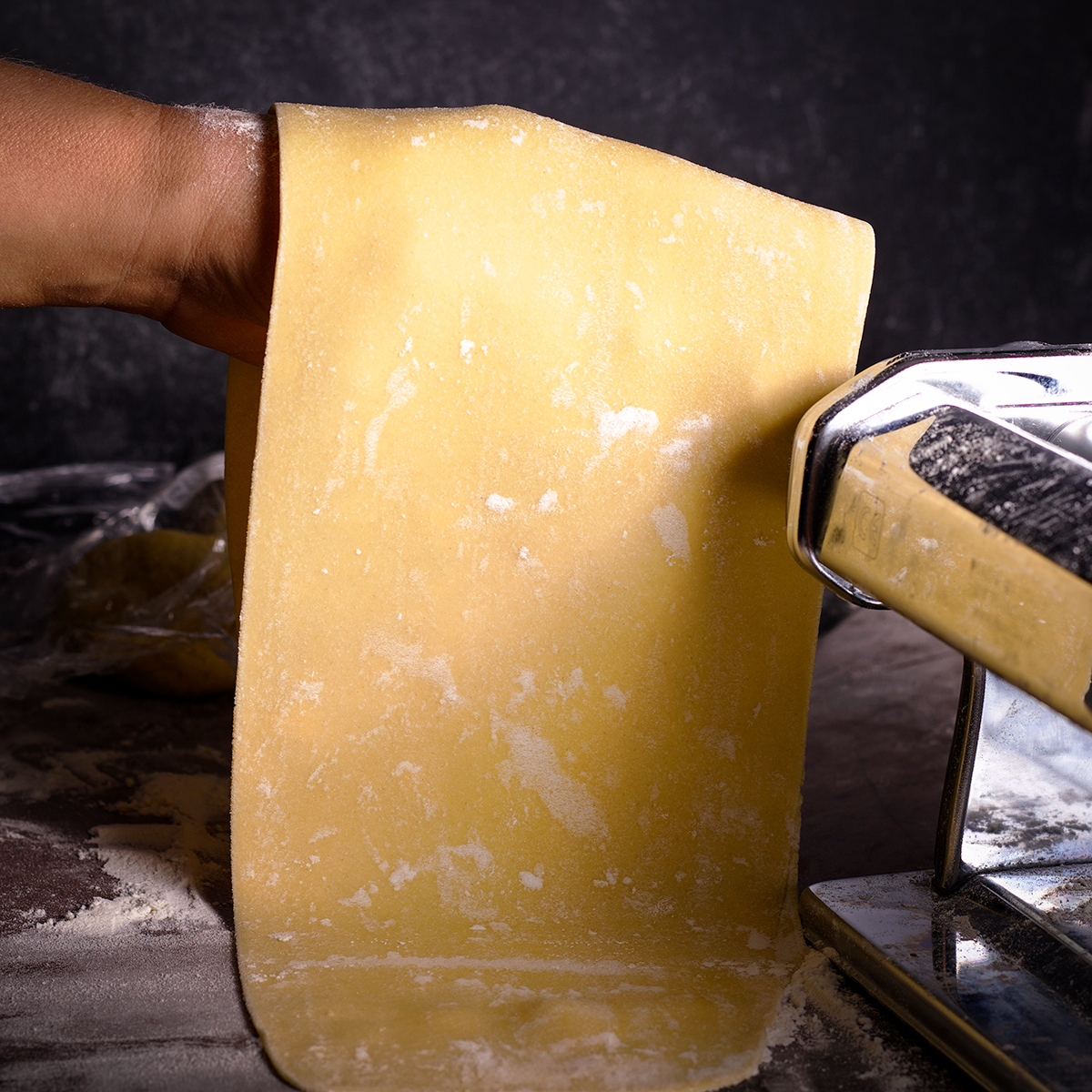
When the pasta is at your desired thickness, it's time to feed it through the spaghetti noodle cutting attachment.

Roll it through the noodle cutting attachment to cut it into strands of spaghetti.

As you cut the dough into spaghetti noodles, lay them out on a tray. You can also hang them on a pasta drying rack, or even hang the strands on clothes hangers that you suspend from the knobs of your kitchen cabinets.
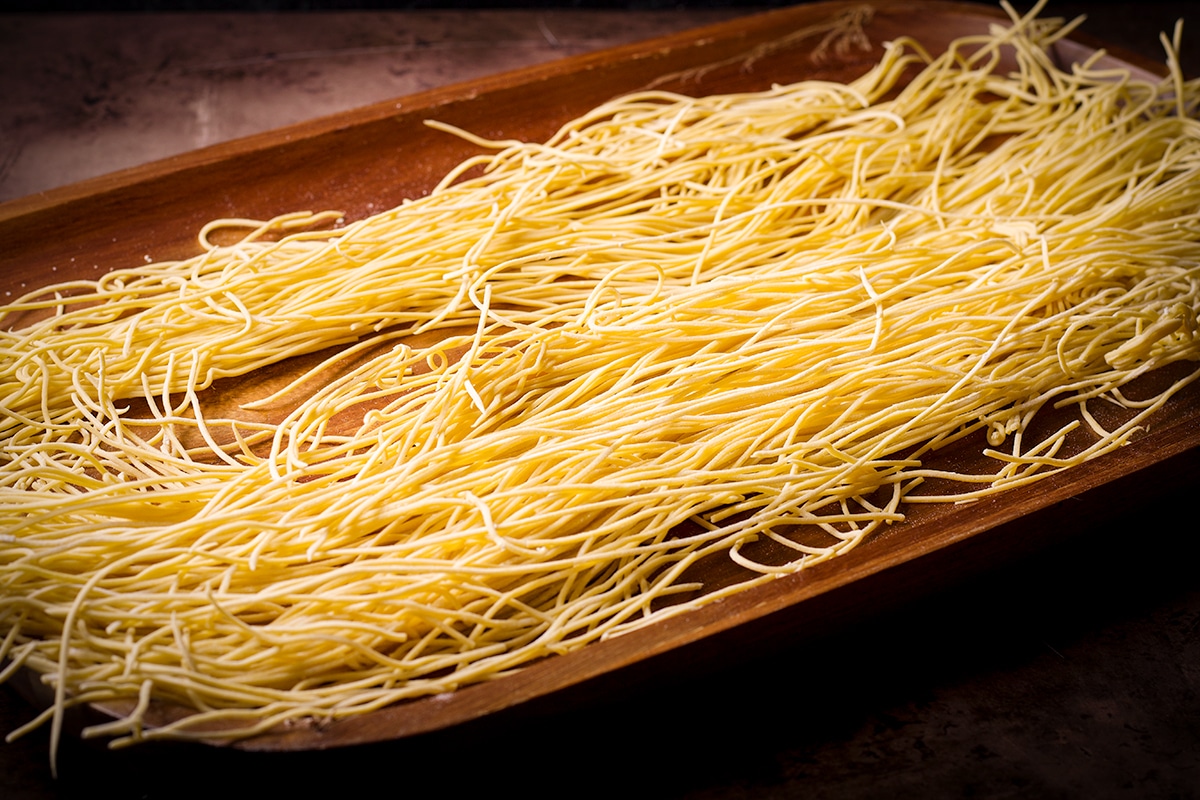
Allow the pasta to dry for at least a couple of hours before cooking. Or, let it dry completely and store in an airtight container.
I know that mixing pasta dough in a bowl instead of on a work surface is not what any Italian grandmother would do. But, mixing it in a bowl means that any egg escapes from the flour it will be contained, making the process a bit less messy, which I find appealing, especially in my tiny kitchen with very limited counter space. However, how you mix the dough is 100% up to you. If you'd rather do it directly on the work surface, go for it.
Fresh spaghetti tips and tricks
I first learned how to make homemade pasta several years ago from my friend Judy. I couldn't believe how much more flavorful and delicious fresh pasta was when compared to the standard packages of dry pasta available in supermarkets.
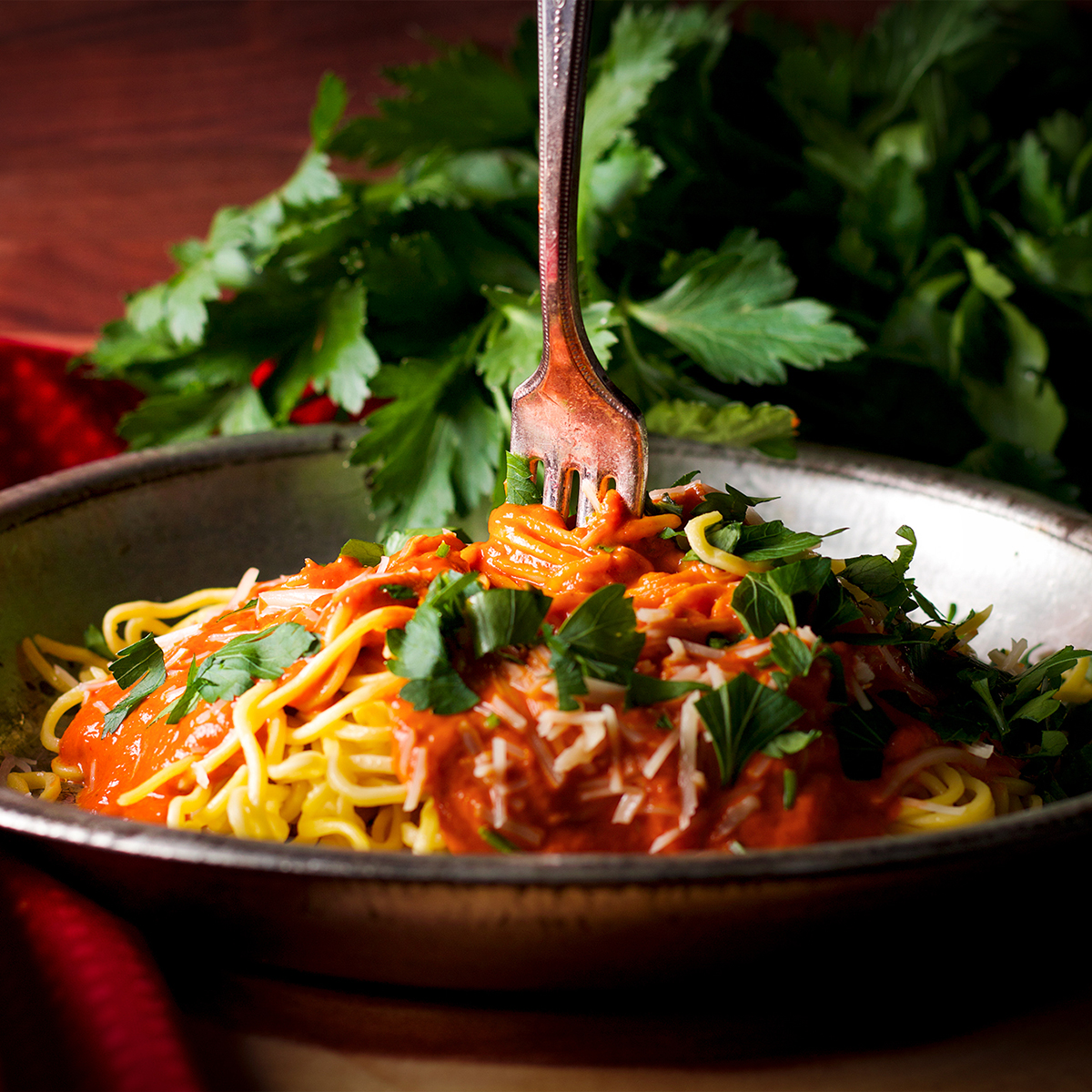
After making hundreds of batches of fresh pasta over the past few years, I've learned a few tricks that are essential to making pasta with a rich, buttery flavor and a tender yet chewy texture that will rival anything you'll get at a 5-star restaurant.
- Knead the dough for 10 minutes. Many homemade pasta recipes will tell you to knead the dough for just a few minutes but I have found that the best texture comes from kneading the dough for at least 10 minutes. And honestly, a few more minutes of kneading in exchange for pasta with a toothsome, silky smooth, springy texture is 1000% worth it to me.
- Allow the dough to rest for at least 5 hours. I made fresh pasta for years without really understanding the importance of letting the dough rest for long enough. Now I know better. The best texture and flavor is achieved when you allow the dough to rest for 12-24 hours, but 5 hours is really the minimum for the most flavorful spaghetti noodles with the silkiest texture.
- Let the freshly cut spaghetti noodles dry before cooking. Another mistake I made for years was cooking fresh spaghetti noodles right after cutting the dough. Allowing the noodles to dry for a couple of hours ensures that they will cook more evenly. When you dump freshly cut pasta straight into boiling water it can come out mushy and even somewhat slimy. Allowing it to dry is the simple trick to evenly cooked pasta simmered to a perfect al dente.
FAQs
My three favorite recipes in which to use leftover egg whites are Italian Meringue Buttercream, Angel Food Cake, and Chewy Chocolate Brownie Cookies.
But you can also use them to make a couple of egg white omelettes or freeze them for another day.
I use a Marcato Pasta Maker. I use the hand crank to move the pasta through the machine but you can purchase a motor that attaches to the machine if you like. By the way, if you've never used a pasta maker before you might want to know that turning the hand crank is extremely easy and takes very little effort. It can be kind of handy to have a motor, but is 100% unnecessary.
No! Having a pasta machine certainly makes the whole process easier, but people have been making fresh pasta from scratch for much, much longer than pasta makers have existed.
If you want to make pasta without a machine simply use a rolling pin to roll it out into thin sheets. I recommend still working with ¼ of the dough at a time, just as the recipe directs. Use a knife to cut the pasta sheets into thing spaghetti noodles, or use this wood spaghetti cutter rolling pin or an Italian Pasta Chitarra. A Chitarra is a tool that's been used to make pasta for hundreds of years.
Absolutely! This is a great all-purpose pasta dough recipe that can be used to make any kind of pasta you desire.
Recipes to make with fresh homemade spaghetti noodles
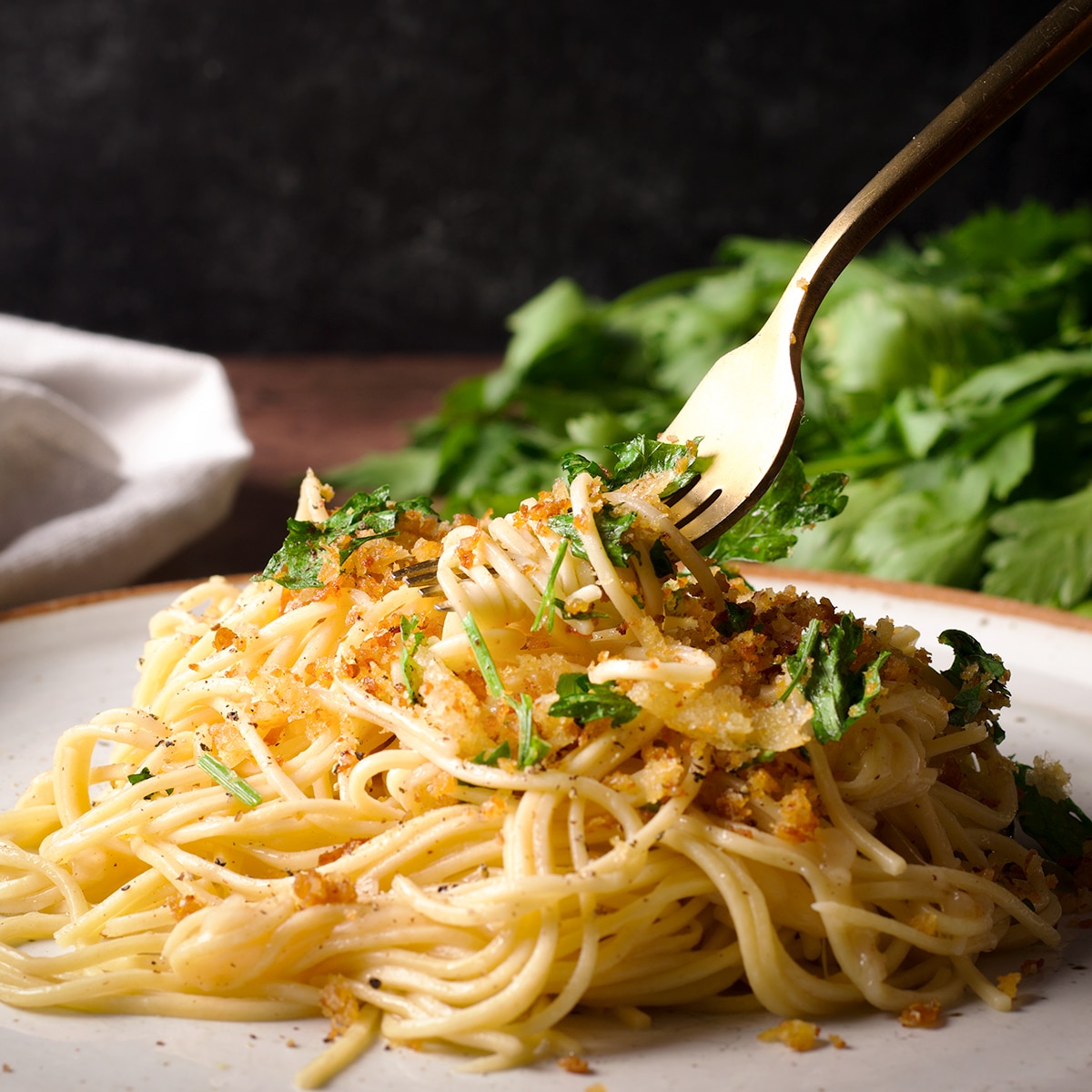
Thre spaghetti dishes I love to make on weeknights when I want a delicious meal without much effort are brown butter sauce pasta with crispy bread crumbs (pictured above), miso buttered pasta with salmon (sometimes I make it without the salmon), garlic chipotle pasta, and spaghetti puttanesca. All three require very few ingredients and come together quickly.
The trick for quick weeknight spaghetti meals that use fresh pasta is to make the pasta ahead of time and leave it to dry. Once dried, the pasta will keep for weeks and you can just pull it out of the pantry to boil whenever you like.
One of our youngest daughter's favorite meals is chicken piccatta, a dish I always make with fresh spaghetti noodles because it makes a good thing even better.
For a uniquely simple meal, toss spaghetti noodles with this avocado pesto sauce from Janelle at Plant Based Folks. It's creamy and flavorful but does not contain any additional cheese or oil.
For all you seafood lovers, this seafood pasta recipe with white sauce is a deliciously creamy Italian dish that's just begging to be made with fresh pasta.
And, of coure, there's everyone's favorite - spaghetti with marinara. This is the homemade marinara sauce I've been making for decades and it's still one our all time favorite recipes.
Coming in at a close second to spaghetti marinara is this creamy roasted red pepper sauce. I especially love to keep some red pepper sauce in the freezer and when I've thought ahead enough to have some dried spaghetti noodles in the pantry, an incredible meal is literally only minutes away.

+ Subscribe to my newsletter for new and exclusive recipes in your in-box every month! As a full time traveler, living, working, cooking, and baking from a 5th wheel RV, it's also where I share our experiences of life on the road.
📖 Recipe
Homemade Spaghetti Noodles
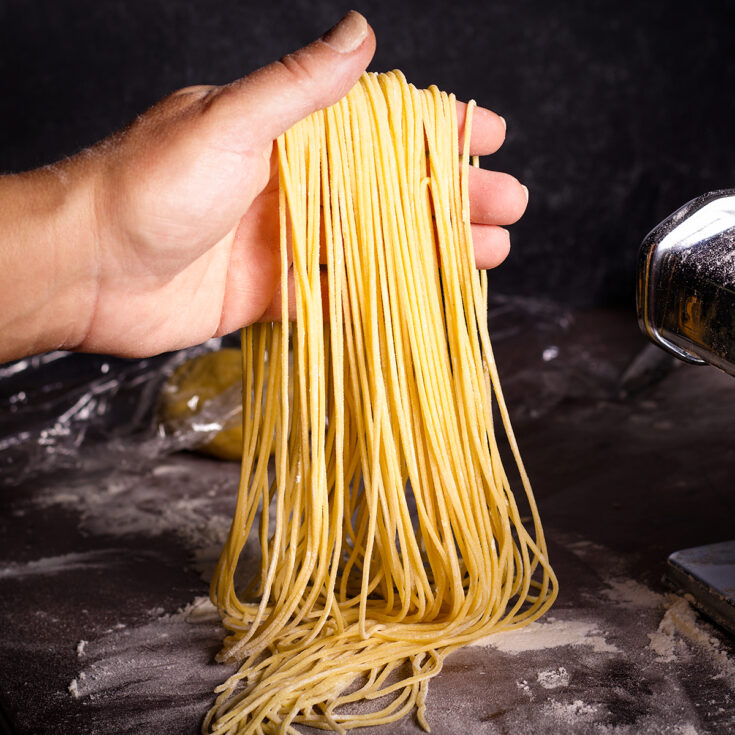
This recipe for homemade spaghetti produces noodles with a rich, buttery egg yolk flavor that is so good you may never purchase dried pasta again!
Ingredients
- 1 ¾ cups (210 grams) all-purpose flour
- 6 large egg yolks + 1 whole egg (140 grams total)
- 1 tablespoon extra virgin olive oil
- 1 tablespoon milk
Instructions
- Dump the flour into a large bowl or onto a clean work surface. Use your fingers to create a well in the center of the flour. In a separate bowl, whisk the egg and egg yolks just to combine, then pour them into the center of the flour. Add the olive oil and milk.
- Using a fork, start whisking the eggs, gradually incorporating the flour bit-by-bit. Continue to whisk, pulling more and more flour into the eggs, until a soft, shaggy dough begins to form. This will take a couple of minutes. At this point, it's unlikely that all of the flour has been incorporated, which is ok.
- Dump the whole shaggy mess out onto a clean work surface and use your hands to begin to knead it. To knead, fold the dough over onto itself, press it down with your palm, and folding it over again. As you knead, incorporate more and more of the flour. Continue until you have a smooth elastic ball of dough that is not sticky at all, but not so dry that it's cracking. This should take at least 10 minutes. It's important to not skimp on the kneading time. If you slice the dough with a sharp knife, you should see very few air bubbles.
- Wrap the dough in plastic wrap and let it rest in the refrigerator for at least 5 hours and up to 1 week.
- When you're ready to cut it into spaghetti noodles, unwrap the dough and cut it into 4 equal portions. Working with one portion at a time, and keeping the remaining dough covered, flatten the dough out a bit with your hands so that it's thin enough to fit through your pasta machine. Set the pasta machine to the widest setting (usually marked "0"), and feed the dough through the pasta roller. Repeat 10-12 times, folding the dough in half before feeding it back through the rollers. Dust the dough with flour from time to time to keep it from becoming sticky.
- Continue to feed the dough through the machine, gradually changing the settings to thin the pasta. Turn the dial to "2", and run the dough through the machine a couple of times. Then turn the dial to "3", and run the dough through the machine a couple of times. Continue to change the dial settings until the pasta is as thin as you want it to be. (I usually stop at 4 because I like my spaghetti noodles on the thick side.) Remember to keep dusting the dough with flour - if the dough is too sticky when you cut it into spaghetti the noodles will stick together.
- Feed the long sheet of pasta through the spaghetti cutter of your machine. If the strands are too long, use kitchen sheers to cut them to the length you prefer. Lay the noodles out on a tray or baking sheet or hang them from a pasta drying rack. Repeat with the remaining pasta dough.
- Allow the spaghetti to dry for at least a couple of hours; you can also allow it to dry completely and store it in an airtight container in the pantry for up to 1 month.
- To cook spaghetti noodles, fill a large pot with water and add enough salt to make the water taste salty. Bring the water to a rolling boil and add the spaghetti. Cook until "al dente" - if you bite into a noodle it will not be crunchy but it WILL be firm. Dump the spaghetti into a collander set inside the sink to drain. If not using immediately, rinse the noodles with cold water to stop them from cooking.
Notes
- If you're new to fresh pasta making, see the step-by-step photos above.
- Fresh pasta dough will keep in the refrigerator, well wrapped, for up to 1 week. Dried spaghetti noodles will keep in an airtight container at room temperature for up to 1 month.
Recommended Products
As an Amazon Associate and member of other affiliate programs, I earn from qualifying purchases.
Nutrition Information:
Yield:
4Serving Size:
1Amount Per Serving: Calories: 368Total Fat: 13gSaturated Fat: 4gTrans Fat: 0gUnsaturated Fat: 9gCholesterol: 372mgSodium: 127mgCarbohydrates: 43gFiber: 1gSugar: 1gProtein: 17g

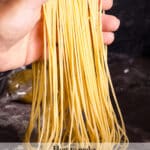
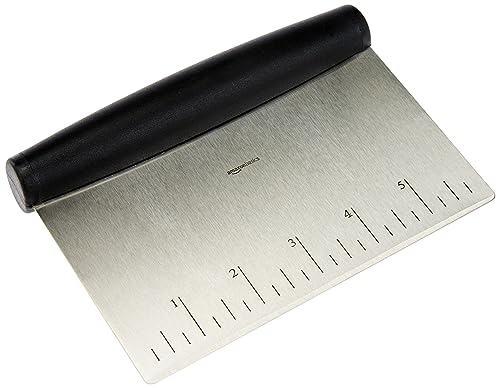



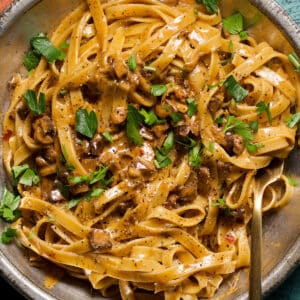
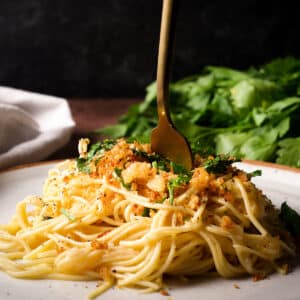
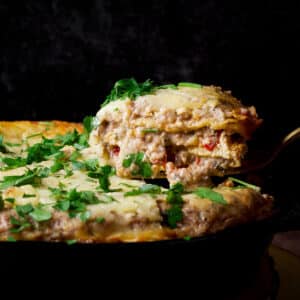
Comments
No Comments